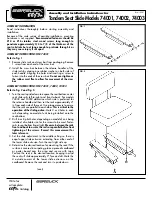
15
Nerve Locating/Mapping
Mode (NMS 410/450X)
2
Locating mode (LOC)
Localisation of nerves by electrical stimulation involves connecting the nerve stimulator
to a conducting, locating needle (not supplied) through which local anaesthetics can
be administered. This procedures involves subcutaneous stimulation of the motor
component of the relevant peripheral nerve, to ‘locate’ the nerve.
•
Select this mode by inserting the Nerve Locating / Mapping cable.
•
The STIMPOD will automatically default to the Nerve Locating current range (0.00 -
5.00 mA) and display the ‘ LOC ’ indicator.
Mapping Mode (MAP)
Percutaneous nerve mapping enables the anaesthesiologist to map out a particular
superficial nerve prior to nerve location with the needle. This is accomplished by
stimulating the motor component of the relevant peripheral nerve percutaneously with
the nerve mapping probe. This technique ensures a higher success rate for directing the
needle to the correct nerve.
This mode offers the user the means to do nerve mapping and locating without having
to switch or unplug cables.
When inserting the Nerve Mapping / Locating Cable, the STIMPOD will default to the Nerve
Mapping current range (0-5mA). Current will be directed to the Nerve Mapping probe and
the STIMPOD will attempt to stimulate. The moment that the needle penetrates the skin
the cable will sense it and inform the STIMPOD. The stimpod will switch to Nerve locating
mode. If contact between the needle and patient is broken, and the nerve mapping probe
touches the patient, STIMPOD will switch back to the nerve mapping mode and start
monitoring the needle - patient connection again. Whenever the nerve mapping probe
and the nerve locating needle simultaneously make contact with the patient the needle
will have first priority.
•
This mode is selected when the Nerve Mapping / Locating cable is inserted.
















































